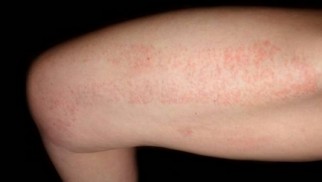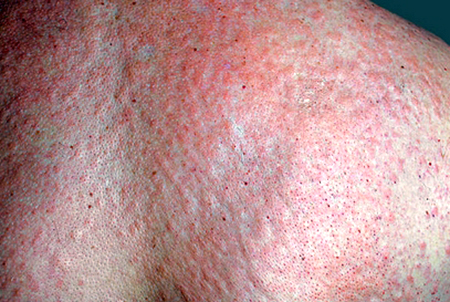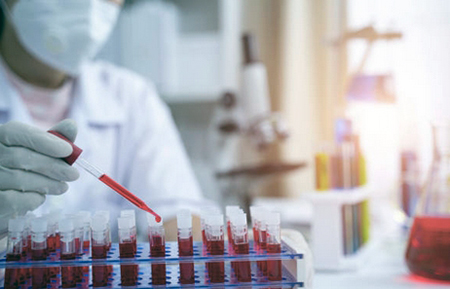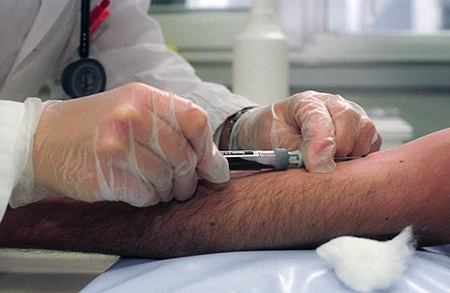What is erythremia and how is it treated?


Sudden redness of the skin and itching, which intensifies when taking a bath or shower, are most often attributed to allergies. Soap, shampoo, shower gel are first blamed for its appearance. And when the pathological reaction does not go away even after the refusal of such funds, the chlorine contained in the tap water is under suspicion. However, in fact, these symptoms can be caused by a serious bone marrow disorder called erythremia, so if you experience itching and discoloration of the skin, be sure to consult a hematologist.
Short information about erythremia
The essence and symptoms of pathology
Another name for erythremia is polycythemia vera, which comes from the Greek words "a lot", "cell" and "blood", which fully reflects the essence of the problem. The fact is that this disease is a benign tumor process of the hematopoietic system associated with excessive myeloproliferation, i.e. hyperplasia of the cellular elements of the bone marrow. As a result, they begin to produce too many red blood cells and platelets, which leads to an increase in the total mass of circulating blood (sometimes almost doubled), an increase in its viscosity, a slowdown in blood flow rate, clogging of small capillaries and an increased risk of blood clots. Most often, the disease occurs in adults and older males. The average age of those affected by the disease ranges from 60 to 79 years. However, young people can also get sick.
In women, erythremia occurs one and a half times less often than in men, but more often it begins earlier and is more difficult. It is known that there is a familial predisposition to polycythemia vera, but the exact mode of inheritance is not yet clear.
Erythremia symptoms

The most common complaint with erythremia is severe itching in the hands or feet in about 40% of patients. It is usually exacerbated by contact with warm water, which is associated with abnormal release of serotonin, histamine, and prostaglandins. Due to the too slow movement of blood, as a result of which most of the hemoglobin has time to go into the restored form, the human skin acquires a reddish-cherry color, which is especially noticeable in its open areas: the face, neck, hands, ankles and calves.
Sometimes with erythremia, dilated veins located in the neck are also visible, the conjunctiva and whites of the eyes turn red, and the mucous membranes swell slightly.
A fairly common symptom of the disease is erythromelalgia - the appearance of burning pain in the tips of the fingers and toes, redness or blue discoloration of the skin on these parts of the body.
Erythromelalgia is caused by an increase in the number of platelets and an increase in platelet aggregation, which causes tiny blood clots to form in the small capillaries. Approximately 20% of patients with polycythemia develop, among other things, gouty arthritis. Another concomitant disease that affects about 10-15% of patients with erythremia is gastric ulcer and duodenal ulcer. Thrombosis of small vessels leads to trophic disorders in the mucous membranes of these organs, which increases their susceptibility to damage by the H. pylori bacterium. As a compensatory reaction of the vascular bed to an increase in blood viscosity, blood pressure rises. Headaches can also be non-specific symptoms of the disease, sometimes developing into painful migraines with visual impairment. Many patients complain of pain in the heart, bones, and epigastric region. They often experience dizziness, tinnitus, chronic fatigue, mood swings, decreased concentration, and impaired cognitive function.
Diagnostic principles

Quite often, in the early stages, erythremia is asymptomatic. Sometimes it is diagnosed quite by accident, after a general blood test, which the patient gives for a completely different reason. In this case, the main symptom of the disease is a too high hemoglobin content in the blood (180–220 g/l) and a change in the hematocrit, i.e. the ratio of blood and plasma corpuscles (65–80%). In people with polycythemia vera, the number of red blood cells in a cubic millimeter of blood often exceeds 8 million, and the norm for adults is 4–6 million. A complete blood count also shows an increase in the number of platelets and leukocytes, a decrease in the erythrocyte sedimentation rate (ESR).
Functional diagnostics, such as ultrasound of internal organs, often reveal an increase in the size of the liver and spleen. And additional laboratory tests, which are prescribed for suspected erythremia, reveal an increase in the concentration of uric acid, a change in the leukocyte formula, a decrease in the parameters of erythropoietin, a hormone that regulates the formation of erythrocytes, as well as a mutation in the JAK2 tyrosine kinase gene.
Bloodletting treatment

Erythremia belongs to chronic incurable diseases, it is fraught with serious and life-threatening complications. First of all, they include thrombotic events, for example, embolism of arterial and venous vessels of the brain, lungs, spleen, and lower extremities.
Paradoxically, people with erythremia are prone to bleeding, especially with gastric ulcer and duodenal ulcer. They also often develop gallstone disease and cirrhosis of the liver and are at increased risk of developing nephrosclerosis and kidney stones.
To avoid such severe consequences, it is very important to timely diagnose and correctly treat erythremia. The main task of therapy is to normalize the amount of blood. For this, one of the most ancient medical techniques is used - bloodletting, or, using modern terminology, phlebotomy. It is usually prescribed when the hematocrit is above 55%. About 300-500 ml of blood is removed from the body at a time, repeating the procedure every 2-4 days until the hematocrit drops to 45% for men or 42% for women, and the hemoglobin level drops to 140-150 g/l.

It is noteworthy that bloodletting not only reduces the risk of blood clots, eliminates skin redness and itching, but also improves the cognitive functions of patients with erythremia. If phlebotomy does not help or the patient has contraindications to it, for example, thrombocytosis, it is replaced with chemotherapy (cytoreductive therapy, for instance, with Hydrea), which also helps to reduce the mass of red blood cells.
Bloodletting can also be replaced by erythrocytapheresis, or extracorporeal hemocorrection. Its most famous type is plasmapheresis. In general, modern hematology has about three dozen methods of extracorporeal hemocorrection. The treatment regimen for erythremia often includes injections of interferon, antihistamines, corticosteroid hormones.
To eliminate erythromelalgia and prevent thrombotic complications, low doses of acetylsalicylic acid (75–81 mg per day) or other drugs that reduce platelet aggregation are prescribed. Today in the West, studies are underway on the use of selective inhibitors of JAK2 tyrosine kinase, which may help to completely cure or at least block the progression of erythremia. However, such drugs are only in the early stages of clinical trials. And while this disease is considered incurable, it is important to consult a doctor at the very first symptoms in order to at least slow down the development of dangerous complications.
The course of erythremia is usually divided into several stages:
- First. Lasts about 5 years from the onset of the disease, is characterized by an asymptomatic course or moderate manifestation of symptoms without any complications.
- Second. It develops within 5-15 years. A complete blood count shows a high content of red blood cells, platelets and leukocytes. Symptoms become more pronounced, the patient has bleeding, thrombosis, and the size of the spleen and liver increases.
- Third. It usually begins 15–20 years after the onset of the disease. At this stage, the number of erythrocytes, leukocytes and platelets in the peripheral blood does not grow, but, on the contrary, decreases, the liver and spleen increase significantly in size, and serious complications develop.
Post by: Rachel Lewis, Senior Medical Advisor at Medibank, Sydney, New South Wales, Australia
(Updated at Apr 13 / 2024)
Hydrea articles:
Some of the trademarks used in this Web Site appear for identification purposes only.
All orders are reviewed by a licensed physician and pharmacist before being dispensed and shipped.
The statements contained herein are not intended to diagnose, treat, cure or prevent disease. The statements are for informational purposes only and is it not meant to replace the services or recommendations of a physician or qualified health care practitioner. If you have questions about the drugs you are taking, check with your doctor, nurse, or pharmacist.